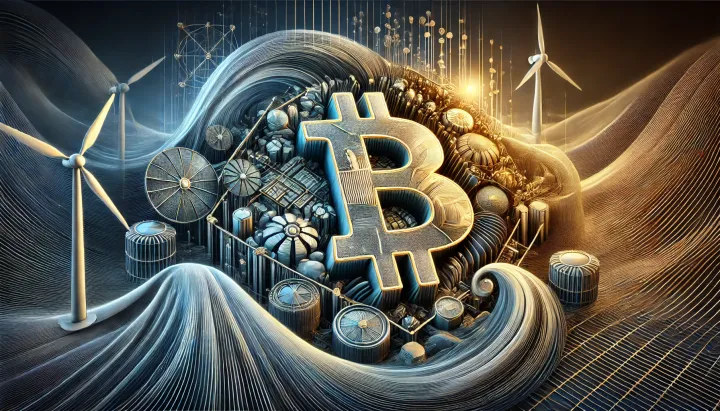Mining Centralization Risks Bitcoin’s Decentralization
The April 16, 2025 episode of What Bitcoin Did features Bob Burnett explaining how pool and chip supplier concentration threaten Bitcoin’s decentralized ethos.

- My 'briefing notes' summarize the content of podcast episodes; they do not reflect my own views.
- They contain (1) a summary of podcast content, (2) potential information gaps, and (3) some speculative views on wider Bitcoin implications.
- Pay attention to broadcast dates (I often summarize older episodes)
- Some episodes I summarize may be sponsored: don't trust, verify, if the information you are looking for is to be used for decision-making.
Summary
The April 16, 2025 episode of What Bitcoin Did features Bob Burnett explaining how pool and chip supplier concentration threaten Bitcoin’s decentralized ethos. He outlines a five‑layer miner stack—energy, ASICs, systems, operations, block creation—to show where real differentiation lies and warns of finite low‑cost energy competing with heavy industry. Burnett highlights geopolitical mining drives and the impending block‑space commodity market, calling for transparent governance and sustained vigilance.
Take-Home Messages
- Complacency Hazard: Institutional adoption and ETF approvals risk dulling community vigilance against centralization threats.
- Layered Value: Differentiation comes from energy self‑production and block‑template control, not mere hashing.
- Energy Scarcity: Only about 1,500 TWh of sub‑5¢/kWh energy is globally available; miners must innovate with micro‑generation to compete.
- Geopolitical Stakes: Nation states pursuing hash power for economic sovereignty could reshape global mining dynamics.
- Block‑Space Commodity: Scarce base‑layer transactions will be traded like hotel rooms on New Year’s Eve, necessitating fair market frameworks.
Overview
Bob Burnett begins by warning that comfort from strategic reserves and Bitcoin ETFs can breed complacency, leaving the network exposed to concentration risks. He presents a miner stack model—comprising energy, ASIC chips, system assembly, operational efficiency, and block creation—to illustrate where value and centralization may accrue in the mining ecosystem. Burnett criticizes operators who delegate block‑template authority to a few large pools, enabling potential censorship and consensus manipulation.
He quantifies mining’s energy footprint—200 TWh of the roughly 1,500 TWh available at sub‑5¢/kWh—highlighting competition with high‑performance computing and heavy industry. Burnett argues that only miners producing their own energy can ensure long‑term viability and resilience. He draws on African Gridless projects as exemplars of bottom‑up, micro‑scale energy strategies.
Turning to hardware, Burnett discusses how offshore ASIC fabrication and component tariffs disrupt supply chains, urging investment in domestic chip design and diversified fabrication. He praises collaborative efforts like Ocean Protocol’s transparent share‑based payouts as an alternative to opaque Full Pay‑Per‑Share (FPPS) pools, noting a double‑digit payout improvement for participants.
Burnett then examines geopolitical drivers, citing Israel, Russia, and Iran securing hash power to preserve economic sovereignty amid sanctions and reserve vulnerabilities. He anticipates a rise in “unknown” mining actors as states covertly build capacity, stressing the need for forensic analysis and policy responses.
Finally, Burnett forecasts block space evolving into a tradable commodity, akin to hotel rooms on New Year’s Eve, with futures markets allocating scarce transaction slots. He urges stakeholders to design these markets for open access and transparency to prevent speculative gatekeeping.
Stakeholder Perspectives
- Regulators: Craft policies that balance economic sovereignty claims with protections against mining monopolies.
- Energy Providers: Weigh grid demands and renewable investments against micro‑generation partnerships with miners.
- Pool Operators: Defend FPPS models while facing pressure to adopt transparent, share‑based payout systems.
- Mining Firms: Pursue vertical integration—energy, hardware, and block control—to mitigate centralization and supply risks.
- Institutional Investors: Demand assurance of fair block‑space access and governance safeguards before committing capital.
Implications and Future Outlook
Mining centralization imperils Bitcoin’s permissionless ethos by concentrating block‑creation power in a handful of entities. Unless hashrate distribution and block‑template authority disperse, potential censorship and reorganization attacks could erode user trust and transaction finality. Early adoption of decentralized pool protocols and transparent governance frameworks will be critical to preserving network integrity.
Energy scarcity will force miners to innovate with micro‑generation and distributed power solutions, reducing reliance on grid constraints and geopolitical supply chains. Policymakers working with renewable and waste‑to‑energy sectors can unlock underutilized resources, aligning mining growth with sustainability goals. Collaboration between regulators and industry will determine whether Bitcoin mining supports or strains local grids and environments.
The commoditization of block space will spur complex financial markets, from futures to forward contracts, defining how scarce transaction slots are allocated. Well‑structured marketplaces must prioritize equitable access to prevent institutional gatekeeping. Developing regulatory guardrails for block‑space trading will shape Bitcoin’s future as both a monetary and economic infrastructure.
Some Key Information Gaps
- What governance models can mitigate mining centralization among top pools while preserving network efficiency? Defining decentralized coordination mechanisms is essential to guard against censorship and maintain consensus security.
- What strategies can mining organizations use to secure and manage limited sub‑6¢/kWh energy resources for sustainable growth? Identifying scalable micro‑generation and waste‑to‑energy approaches will inform resilient operational models.
- How can economic sovereignty via block‑space control be balanced against the risk of geopolitical mining races? Clarifying policy frameworks can help states pursue security without compromising permissionless design.
- What technical defenses can guard against chain reorganizations by entities controlling 30–45% of hash power? Developing adaptive confirmation protocols and monitoring tools will strengthen transaction finality.
- What market designs could support the financialization of block space while ensuring open access for all participants? Crafting transparent, fair trading structures will prevent speculative gatekeeping of scarce transaction slots.
Broader Implications for Bitcoin
Monetary Sovereignty Redefined
Bitcoin’s fixed‑supply model and decentralized consensus challenge traditional currency issuance frameworks. As nation states and institutions vie for hash power to assert economic autonomy, the notion of monetary sovereignty may shift from state‑centric control to distributed block‑space governance. This could spur hybrid reserve strategies blending Bitcoin with legacy assets to preserve credibility.
Energy Infrastructure Transformation
The imperative for micro‑scale energy production in mining could catalyze new distributed generation projects and waste‑to‑energy innovations. Regions leveraging renewable or stranded resources for mining may attract investment in grid upgrades and sustainable infrastructure. Over time, these developments could redefine local energy markets and foster cross‑sector collaboration between miners, utilities, and regulators.
Financial Market Innovation
The emergence of block‑space futures and forward markets represents a novel commodity class rooted in protocol‑level scarcity. Creating robust regulatory and risk‑management frameworks will be vital to prevent market manipulation and ensure fair access. Success in this arena could position Bitcoin as a blueprint for other digital‑asset commodities and reshape financial market conventions.



Comments ()